LG G1 (OLED65G1) review: the best OLED TV at the T3 Awards 2021
The LG G1's brighter OLED panel is just the upgrade the technology needs



The LG G1 is beautiful to look at when it’s switched off, and impossible to tear your eyes from when it’s on.
-
+
Improved OLED brightness and colour
-
+
Excellent design
-
+
HDMI 2.1 and cutting-edge gaming tech
-
-
A big price jump over the LG C1
-
-
Stand not included
-
-
No HDR10+
Why you can trust T3

The LG G1 is a seriously big deal. Any new LG OLED TV matters to AV fans, of course, since they're some of the best TVs in the world. But the G1 ups the ante by being the first LG OLED in an age that claims a substantial hardware advance on its predecessors, rather than relying on new software and minor panel ‘tweaks’.
What’s more, the biggest beneficiary of the new panel design is the one area of picture performance that’s arguably OLED’s main Achilles' Heel: Brightness. Even the best OLED TVs struggle to make it past the same brightness as mid-range LED TVs, instead relying on the their far superior black levels to create big HDR contrast. And it worked!
But it meant that they run the risk of looking washed out in bright rooms, and it always left the tantalising possibility that they could offer even greater dynamic range if the brightness could be lifted. And now here we are, with a new brighter set that's so good, it won both Best OLED TV and Best Gaming TV at the T3 Awards 2021.
We're testing the LG OLED65G1 today – the 65-inch version of the set, vying for a place in our list of the best 65-inch TVs.
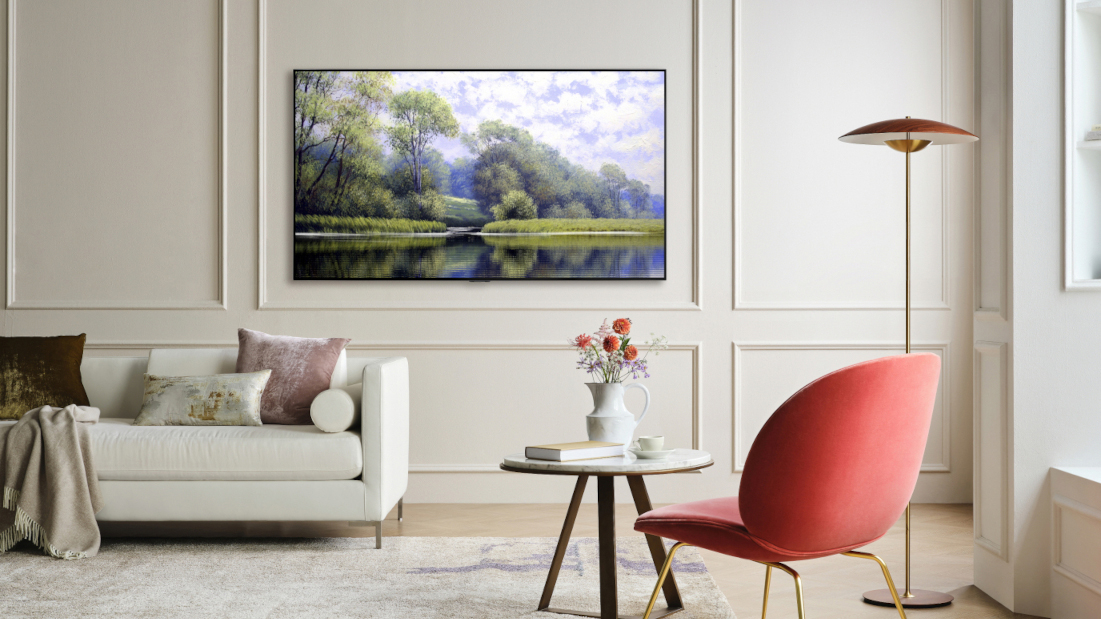
LG G1 review: Price & features
The LG G1 is available in three sizes: the 55-inch LG OLED55G1 for £1,999/$2,199/AU$3,799, the 65-inch LG OLED65G1 for £2,999/$2,999/AU$5,299, or the 77-inch LG OLED77G1 for £4,799/$4,499/AU$9,999.
At first glance the price of the LG OLED65G1 we're testing looks pretty steep. It’s £500/AU$600 more, after all, than LG’s step-down OLED65C1.
The C1 range, though, does not get the new high-brightness panel. And when you start looking at the prices of other OLED TVs that do use high-brightness hardware, the G1’s price starts to look more than fair. Sony’s upcoming 65-inch A90J, for instance, is set to be £3,500/$3,999/AU$5,899, while Panasonic’s HZ2000 from 2020 launched at a distinctly eye-watering £4,300 at 65 inches (no US/AU version was available).
Get all the latest news, reviews, deals and buying guides on gorgeous tech, home and active products from the T3 experts
Since it’s at the heart of the LG G1’s appeal, let’s get straight into the nitty gritty of what apparently makes its new ‘evo’ panel so special.
There are two main strings to its high-tech bow. First, it incorporates a mysterious-sounding (LG isn’t keen on providing lots of technical details about it) high-efficiency layer that’s the main cause of the promised extra brightness.
It also, though, uses new blue and red materials to substantially reduce the wavelengths of the G1’s red and blue output, resulting in greater colour precision and improved blue and red colour peaks. There’s also, for the first time in an LG OLED TV, a new layer expressly devoted to enhancing green.
As we’ve come to learn over the years, a TV’s panel technology is only one part of its wider picture quality story. So it’s no surprise to find LG partnering the G1 with a new processing system designed to get the most out of the new panel technology. Not that this Alpha 9 Generation 4 processor stops at optimising pictures to the capabilities of the evo panel, though.
It also drives a new version of LG’s AI Picture Pro automatic picture processing system. This includes new AI elements (developed by running a huge array of images through a neural network) designed to adjust images based on the type of content they contain.
To be more specific, AI Picture Pro can now recognise if an incoming image contains scenery, a cityscape or night footage, and locally ‘massage’ parts of the picture to enhance this sort of content’s impact and realism. Plus the new processor can look for skin tones and individual objects in the picture and subtly refine and emphasise them without impacting other areas of the picture. All with a view to creating an image that better reflects the way your eyes see the real world.
The LG G1’s new processor also drives a couple of new motion processing options, and a new AI Sound Pro feature that can turn any incoming audio format into a 5.1.2 mix (where the .2 part refers to a pair of height channels).

This sound configuration also reminds us that the LG G1 follows all of LG’s recent OLEDs by carrying a built-in Dolby Atmos sound system. That’s not the only Dolby connection, either, for the set additionally supports the Dolby Vision HDR format. This adds extra scene by scene picture information that compatible TVs can use to deliver more dynamic picture quality results.
The Dolby Vision support sits alongside regular HDR10 and HLG HDR format support – though as always with LG TVs, there’s no support for the HDR10+ system (which operates similarly to Dolby Vision, but is used on fewer services).
Dolby Vision is coming to Xbox Series X and S video gaming later this year too, bolstering LG OLED’s already pretty legendary reputation with high-end gamers.
That reputation has been built on providing outstanding game-friendly connectivity, so it’s no surprise to find this continuing with the G1. All four of its HDMI sockets support the key cutting-edge gaming features of variable refresh rate, automatic low latency mode switching, and 4K 120Hz playback.
LG has also improved its already strong input lag appeal to gamers by getting input lag down to 12.4 and 9.4ms, depending on whether you’re using the Standard or new Boost input lag reduction options (the latter of which apparently aligns the lag-reducing mode with a game’s refresh rate).
The VRR support covers the Nvidia, AMD Freesync (Premium) and HDMI 2.1 standards, while some very welcome new gaming flexibility comes courtesy of a new Game Optimiser system.
New picture adjustment tools here include a genuinely useful series of genre-driven picture and sound presets, and tools for adjusting black levels and peak bright highlights separately, without impacting the rest of the picture.
There’s also a rather prosaically named Fine Tune Dark Areas feature you can use to reduce the impact of a known gamma shift issue that can cause OLED TVs to lose black level depth when switched into VRR mode.
Wrapping up the G1’s status as the biggest leap in OLED technology LG has delivered for years is a revamp of its webOS smart interface. The new home page now takes over your entire screen, for starters, rather than appearing as a row of app icons superimposed over the bottom of the picture.
The emphasis of the new homescreen shifts, sensibly, to trying to offer you direct links to trending content or shows/films that the TV judges you’ll like based on your viewing habits. The old row of apps, though, is still provided at the bottom of the home screen for those who prefer to kick it old school.
Scrolling down from the home screen brings you to content rows allocated to different streaming services, such as Amazon Prime Video and YouTube.
LG’s new smart features include an option to share the TV’s screen on your mobile phone, or listen to the TV’s sound on up to three separate mobile devices.
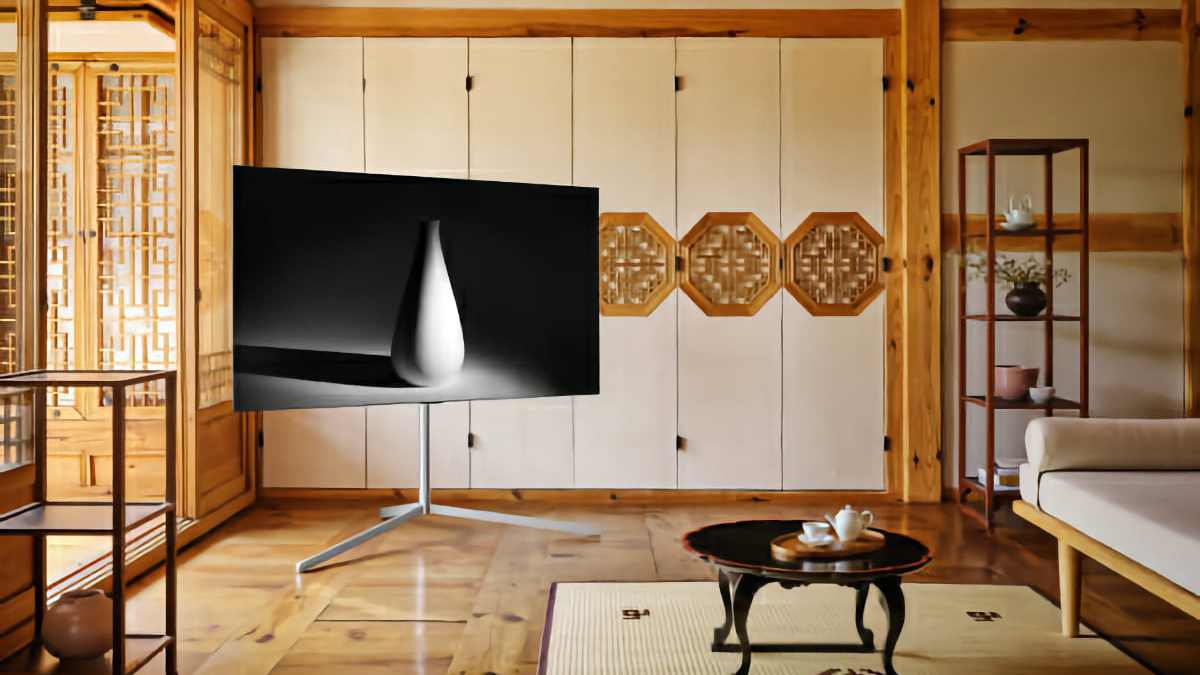
LG G1 review: Picture quality
Pictures on the OLED65G1, regardless of whether you’re watching TV or gaming, are consistently and jaw-droppingly spectacular. Not least because the combination of the new panel and improved processing has enabled LG to either improve or full-on fix just about everything that’s been a problem for the brand’s previous OLED efforts.
As promised, for starters, pictures are brighter. Not always blow-your-socks-off brighter, perhaps, but enough to deliver a noticeable lift to high dynamic range sources in two key ways.
First, where an HDR image is mostly full of bright content, the LG G1 presents it with much more full-screen brightness than we’re used to seeing with ‘regular’ OLED TVs. Second, the very brightest parts of HDR pictures – lamps, streetlights, sunlight reflecting off glass, etc – have a slightly more luminous quality to them.
These two improvements instantly help the G1 deliver a more satisfying and ‘complete’ HDR performance than any LG OLED before. They’re supported, too, by a further slight but again important improvement in colours. With video sources this sees relatively pure blue and, especially, red and green tones enjoying both more subtle tonal delineations and a more natural feel. Especially when they’re presented in a bright situation.
So, for instance, shots of leafy and sun-drenched woodland appear to have more individual leaf definition, and greens avoid the slightly radioactive appearance they can sometimes exhibit on OLED screens. Bright red cars, meanwhile, are more likely to retain the vibrancy of their reds rather than sliding into an unconvincing and unsatisfying orange.
These brightness and colour improvements are especially helpful, it seems to me, with the relatively stark quality of videogame graphics (and the fact that in gaming mode, the TV applies less processing). The daylight levels of Call Of Duty: Black Ops Cold War’s multiplayer levels feel more impactful and ‘real’, while the night-time setting of the Miami level, with its neon lighting against a dark sky, looks more dynamic and intense.
It’s a major relief to find that the LG G1’s new brightness does no damage to the deep, natural black levels that have for so long lain at the heart of OLED technology’s appeal. No low-contrast greyness whatsoever creeps into dark areas, and the occasional black level ‘jumps’ seen with previous LG OLED generations have not been made more common by the relative aggression of the evo panel. On the contrary, such black level inconsistencies have been all but removed on the OLED65G1.
What’s more, the way its slight brightness enhancement of light highlights in mostly dark images actually makes OLED’s legendary black level strengths look all the stronger.
Shadow detailing amid all the blackness is slightly improved from 2020’s LG sets too - especially if you use the AI Picture Pro functionality (something I’ll come back to presently). The only exception to this, oddly, crops up in the Dolby Vision modes, where dark areas using all but the Dolby Vision Bright option can look a little hollow and dominant.

Moving away from benefits attributable specifically to the new evo panel, the LG G1 also impresses with its clarity and detail. Native 4K sources look sharp, full of texture and free of any noise that’s not present in the source. Especially if you’re lucky enough to be playing a native 4K game at a 120Hz refresh rate from one of the new generation of consoles or PC graphics cards.
LG has introduced a new Natural motion processing option for 2021 that does a good job of substantially reducing judder (one of the things consumers most complain about when it comes to OLED TV technology) without leaving the image looking so fluid that it starts to make movies look like soap operas. The Natural mode does, though, throw up some unwanted digital side effects that I personally find almost as distracting as a bit of judder.
This is where the also new Cinematic Movement option comes in. This doesn’t reduce judder as much, but avoids pretty much all digital processing ‘nasties’. So for me it’s the better option with 24p movie sources.
Upscaling of HD sources is handled better than it has been before too. Bags of detail are added now without reducing sharpness or exaggerating noise. Even better, this detail and sharpness is added more intelligently, so that different parts of the picture are impacted by different upscaling rules. This results in more natural, lifelike results.
This brings us to the latest version of LG’s AI Picture Pro image optimisation system. This now joins the best of the automatic picture optimisation systems around, clearly enhancing pretty much every aspect of picture quality from every video source without, crucially, generating really any unwanted side effects.
You can argue that the AI Picture Pro mode is more concerned with optimising sources to the screen’s capabilities than marshalling the TV’s settings to a source’s native qualities. The Cinema and Filmmaker Modes are on hand, though, to provide accuracy if that’s what you want, so the improvements to the AI Picture Pro mode are certainly not a sign of LG abandoning the sort of AV enthusiasts that have been a core part of its OLED audience for so long.
For many users and a lot of content, though, I see the much-improved AI Picture Pro system as a pretty irresistible way of adding more drama, sharpness and dynamism to the viewing experience.
It’s worth adding on this point that the OLED65G1’s accurate Cinema and Filmmaker Mode picture presets are the single greatest beneficiaries of the new evo panel, looking much brighter and richer than they’ve ever looked before on an LG OLED TV. This instantly makes them actually feel more rather than less accurate, especially when it comes to HDR sources.
It’s worth saying again, as I struggle to come up with negative things to say, that the G1 doesn’t deliver, overall, quite such a leap in brightness as I’d been hoping for since LG first announced the evo panel. There are also one or two other issues, such as the potential for flickering while gaming in VRR, the intrusion of a faint magenta tone when viewing from really extreme angles, and an occasional tendency to exaggerate compression noise with some streaming sources.
As with any OLED TV, moreover, it’s also recommended that you treat it with care with respect to bright static image elements to avoid burn-in. For the vast, vast majority of people, this won't be a problem, though.
The negatives column really does look seriously puny compared with everything that’s great about the LG G1’s pictures.
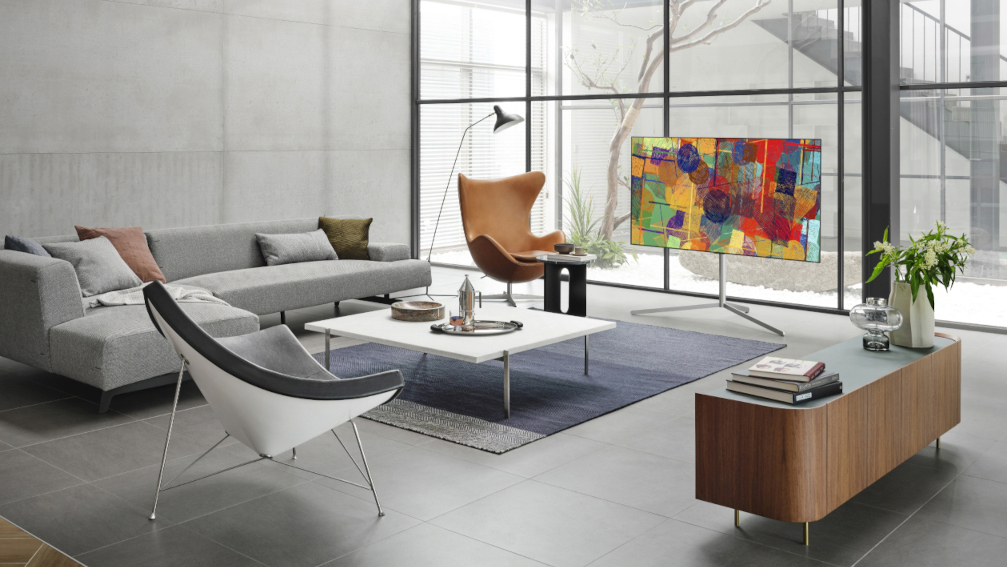
LG G1 review: Sound quality
For the majority of the time, provided you’re careful about how you set it up the LG G1 sounds impressive.
The AI Sound Pro mode follows the lead of the AI Picture Pro mode by seeking to optimise incoming audio of all types to the capabilities of the TV’s speaker system – and it mostly works very well. It instantly increases the sound’s dynamic range; makes the sound project further away from the TV’s bodywork; gives the sound a stronger ‘forward’ presence rather than it appearing to only exist behind the screen; and takes on those big movie moments with plenty of guts and enthusiasm.
The only problem with the AI Sound Pro mode is that it doesn’t accept the limitations of the OLED65G1’s built-in speakers when it comes to bass. As a result, some very deep sounds can succumb to pretty distracting distortions.
The other surprising issue with the LG G1’s audio settings is that you shouldn’t depend on the Dolby Atmos mode if you want the best Atmos experience. This is because the Atmos setting sees loud soundtrack moments becoming strangely muted instead of them ‘blowing up’ like they’re supposed to (and like they do well in AI Sound Pro mode).
The sound is good enough that more casual viewers will be happy without instantly adding one of the best soundbars, but you'll still need something if you want the audio quality to truly match the image quality.
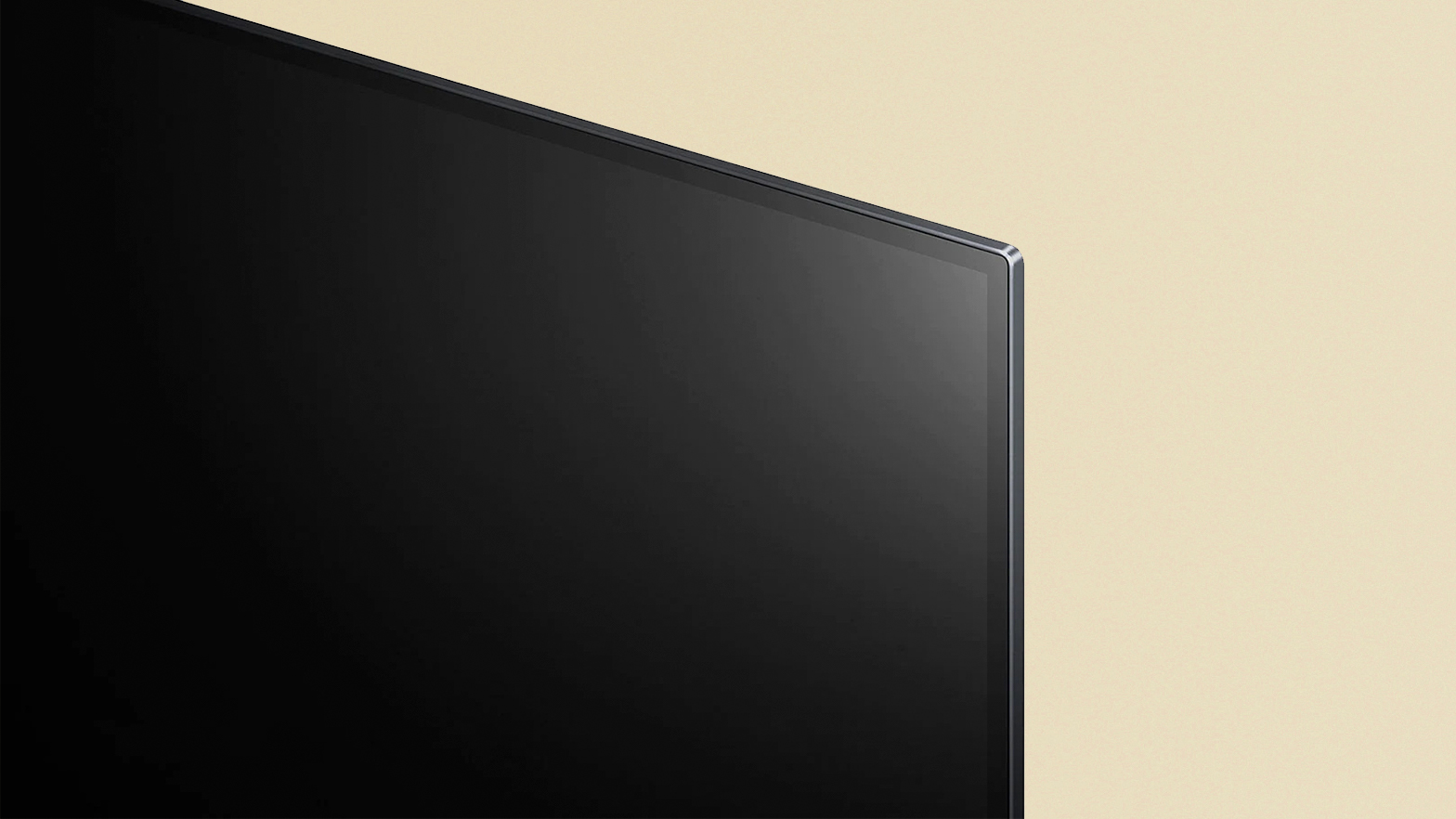
LG G1 review: Design & usability
The OLED65G1 features a refinement on the Gallery design LG introduced in 2020 with a view to creating the ultimate wall-hanging TV. It sports a slim, flat rear, and provides helpful cable channeling for its built-in connections. The 2021 refinements include making the rear substantially slimmer than last year’s, and adding a recess to the rear panel into which the wall mount can slot, enabling the TV to sit completely flush to the wall.
It’s all very pretty… so long as you actually want to wall hang your TV. If not, you’ll have to pay extra for either a pair of desktop feet, or LG’s new Gallery Floorstand option. That's right: there's no stand in the box.
The new webOS smart system has had a mixed impact on how easy the LG G1 is to use. On the upside, the previous long bar of apps had started to become unwieldy, so it makes sense to shift towards the new content recommendation approach. This works well enough once you’ve given it a bit of viewing data to work with, and it’s backed up by excellent voice control and search systems.
Not being able to adjust the running order of the shelves of content you can scroll down to from the home page is frustrating, though. Also, attempts to streamline the LG G1’s set up menus can leave you sometimes feeling unsure of where you’re supposed to go next to find a specific feature. Though to be fair, the voice recognition system often gives you a way round this.
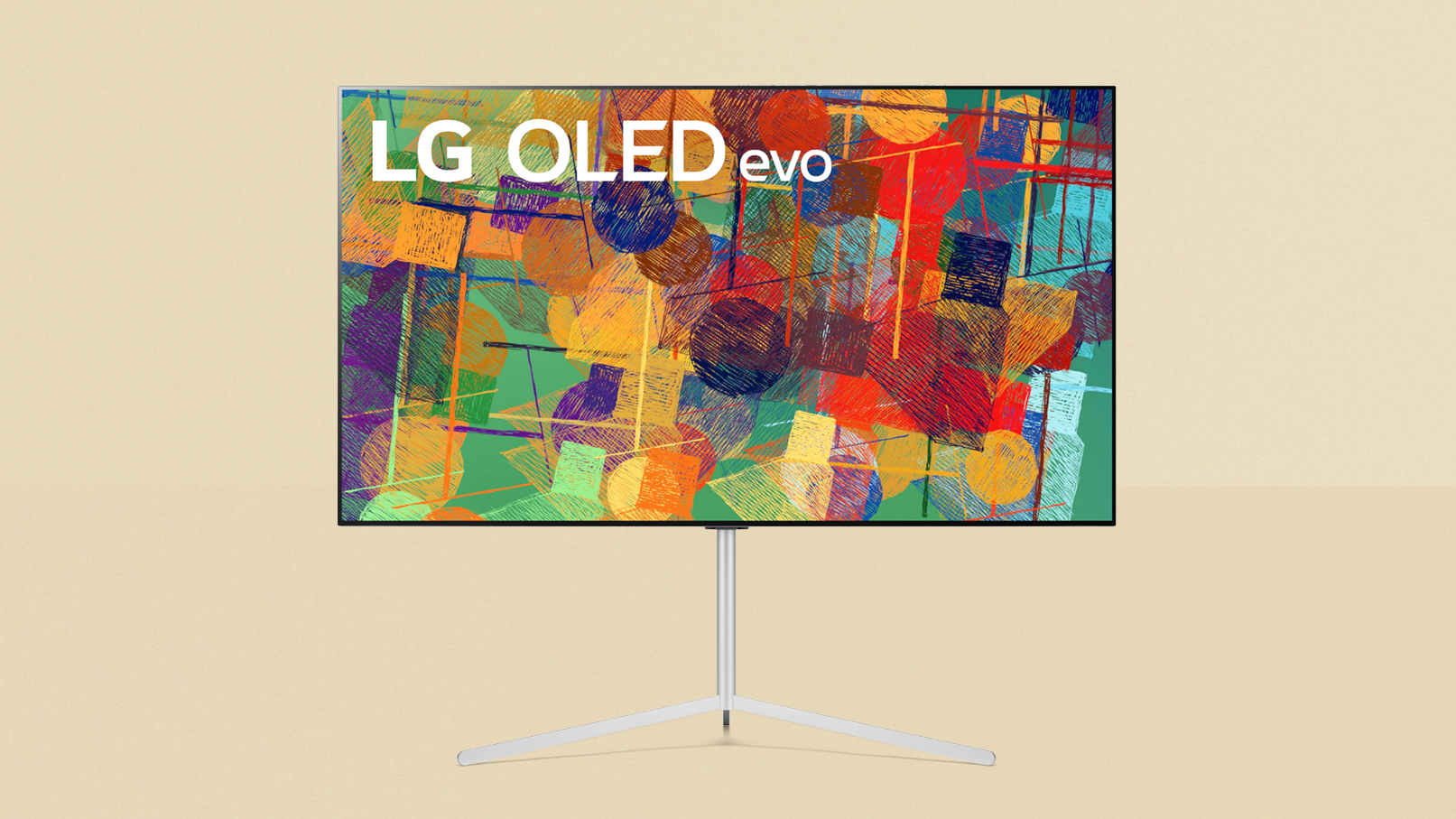
LG G1 review: Verdict
LG’s OLED65G1 is a truly dazzling TV. Its new design delivers on the Gallery concept even more successfully than 2020’s models, and though the new evo panel doesn’t push brightness quite as far as we’d hoped it might, it still yields consistently spectacular results. The set’s new gaming features expand even further the appeal of LG OLEDs to gamers too.
In an ideal world LG’s new C1 might have emerged first, so that we could better judge how successfully the G1 justifies costing significantly more. This review will be updated as needed once the C1 is here, of course, but I feel confident that the level of improvement I’m seeing in the G1 goes beyond anything possible with software enhancements alone.
John Archer has been testing TVs and AV gear for over 25 years, having worked on Home Cinema Choice magazine. He's a contributor to Forbes, TechRadar, Trusted Reviews, Wired and many more places – if you've owned a TV in the last couple of decades, John's probably reviewed it somewhere. He's seen so many hot new technologies come and go, like tears in the rain.
